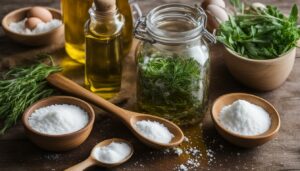Every time a recipe calls for egg yolks, have you ever wondered if you can use the whole egg instead? The answer may surprise you. In this article, we will explore the topic of recipe substitutions, specifically when it comes to using whole eggs or just yolks. Can you achieve the same results? Are there any differences in flavor or texture? Join us as we delve into the world of cooking with eggs and discover some useful culinary tips along the way.
Contents
- 1 Understanding the Roles of Eggs in Recipes
- 2 Basic Substitutions for Egg Yolks
- 3 Egg Substitutions in Cooking
- 4 Egg Substitutions in Baking as a Binder
- 5 Egg Substitutions as a Leavening Agent
- 6 Additional Egg Substitution Tips
- 7 The Science of Substituting Egg Yolks
- 8 Conclusion
- 9 FAQ
- 9.1 Can I use a whole egg when a recipe calls for egg yolks?
- 9.2 What are the roles of eggs in recipes?
- 9.3 What are some basic substitutions for egg yolks?
- 9.4 How can I substitute eggs in cooking?
- 9.5 How can I substitute eggs in baking as a binder?
- 9.6 How can I substitute eggs in baking as a leavening agent?
- 9.7 Do you have any additional tips for substituting eggs in recipes?
- 9.8 What should I consider when substituting egg yolks?
- 10 Source Links
Understanding the Roles of Eggs in Recipes
Eggs play a crucial role in recipes, offering a range of essential functions that contribute to the overall success of a dish. Understanding the roles of eggs, including egg yolks and whole eggs, is key when it comes to substituting them in recipes. Let’s dive deeper into the various roles eggs play in recipes.
Structure
Eggs are known for their ability to provide structure to dishes, particularly when it comes to baked goods. The proteins in eggs coagulate during the cooking process, creating a framework that holds the other ingredients together. This structure helps to maintain the shape and texture of cakes, cookies, and other pastries.
Moisture
Egg yolks are rich in fat, which contributes moisture to recipes. They add richness and tenderness to dishes, making them more flavorful and enjoyable. In contrast, egg whites are primarily composed of water and proteins, helping to create a light and fluffy texture in recipes.
Leavening
When it comes to leavening, eggs play a crucial role in helping recipes rise. The proteins in eggs form a network that traps air and expands during baking, resulting in a light and airy texture. Egg whites, in particular, contribute to the leavening process, helping to create volume and structure in baked goods.
Flavor
Eggs also add flavor to recipes, contributing to the overall taste profile of a dish. Egg yolks, with their rich and creamy texture, provide a distinct flavor that enhances both sweet and savory dishes. The unique taste of eggs is often a key component in recipes, adding depth and complexity.
Understanding the roles of eggs in recipes empowers you to make informed decisions when substituting them. By selecting suitable alternatives that can replicate the functions of eggs, you can still achieve excellent results in your cooking and baking endeavors. Whether you choose to use whole eggs or just yolks, it’s important to acknowledge the specific roles they play and how they contribute to the overall composition of a recipe.
| Roles of Eggs | Egg Yolks | Egg Whites |
|---|---|---|
| Structure | Provide framework and hold ingredients together | Create light and airy texture |
| Moisture | Contribute richness and tenderness | Add water content to recipes |
| Leavening | No significant role | Contribute to volume and structure |
| Flavor | Enhance taste profile with rich, creamy flavor | No significant role |
Basic Substitutions for Egg Yolks
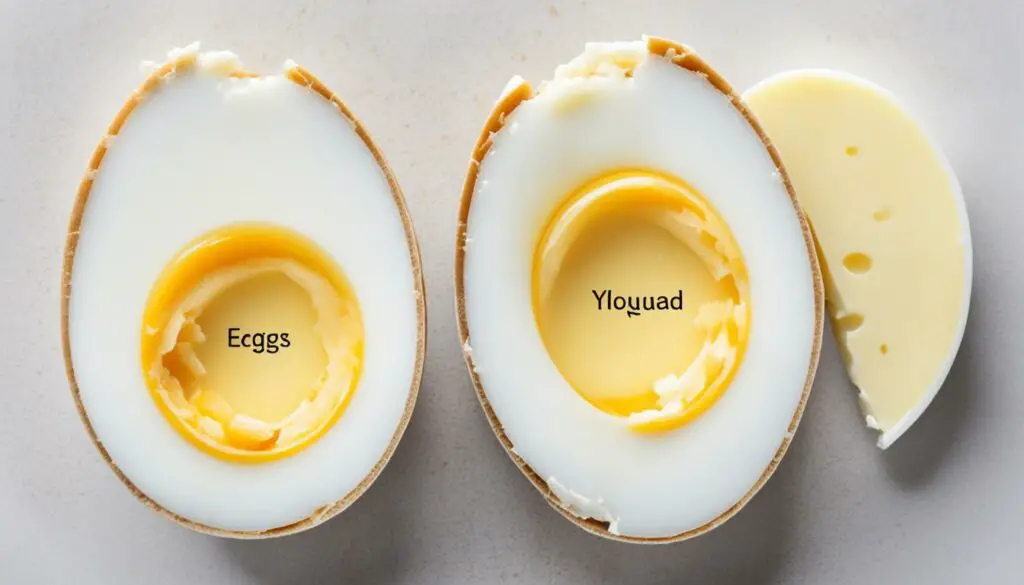
When it comes to substituting egg yolks in your recipes, there are several basic alternatives that you can use. These alternatives provide different properties that can serve as binders or leavening agents, depending on the specific purpose that the eggs served in the original recipe.
- Peanut Butter: Peanut butter can add moisture, richness, and some binding properties to your recipes. It works well in baked goods like cookies and cakes as a substitute for egg yolks.
- Ground Flax: Ground flaxseed mixed with warm water creates a gel-like substance that can mimic the binding properties of egg yolks. Use this alternative in recipes that call for a thickening agent.
- Chia Seed: Similar to ground flaxseed, chia seeds can be mixed with water to form a gel that can substitute for egg yolks. They add a nutty flavor and provide moisture to your dishes.
- Soy Protein: Soy protein powder can be used as a binder in recipes. It helps add structure and moisture to your baked goods.
- Banana: Mashed bananas are a great egg yolk substitute, especially in recipes requiring moisture and binding. They add natural sweetness and give a banana flavor to your dishes.
- Applesauce: Applesauce acts as a binder and moisture replacement for egg yolks in recipes. It works well in muffins, bread, and cakes.
- Agar Agar: Agar agar, a vegan gelatin substitute, can function as a thickening and binding agent. Use it in custards, puddings, or other dishes that require a gel-like consistency.
By using these basic substitutions, you can still achieve excellent results in your cooking and baking endeavors while adapting your recipes to your dietary preferences or restrictions.
Egg Substitutions in Cooking
When it comes to cooking, finding suitable egg substitutions can be crucial, especially when recipes call for a significant number of eggs. Whether you’re making quiches or custards, there are alternatives that can provide the same desirable texture and taste without relying on traditional eggs.
One noteworthy substitute to consider is tofu, which can be pureed and used as a replacement for one egg in a recipe. While tofu may not fluff up like eggs, it can create the perfect texture for dishes that require an “eggy” consistency. By utilizing tofu and other cooking-specific alternatives, you can still enjoy your favorite egg-based recipes while accommodating dietary preferences or restrictions.
Exploring different techniques and ingredients allows you to unleash your creativity in the kitchen and discover new flavors and textures. Here’s a list of egg substitutions commonly used in cooking:
- Tofu: Pureed tofu can be substituted for one egg in recipes that require lots of eggs, such as custards or quiches.
- Applesauce: Unsweetened applesauce can replace eggs in certain recipes, adding moisture and a subtle fruity flavor.
- Yogurt: Use plain yogurt as a substitute for eggs and enjoy the tanginess it brings to your dishes.
- Buttermilk: For recipes that require a moist and tender crumb, buttermilk is an excellent egg substitute.
Experimenting with these alternatives can yield delicious results and add variety to your cooking repertoire. Don’t be afraid to get creative in the kitchen and explore different flavors and textures that egg substitutions can offer. Remember to adjust the measurements and cooking times accordingly to ensure optimal results.
Egg Substitutions in Baking as a Binder
In baking, eggs play a crucial role as binders, holding the ingredients together and ensuring the structural integrity of your baked goods. But what if you don’t have eggs or prefer not to use them? Fortunately, there are several alternatives that can serve as excellent binders in your recipes. Let’s explore some of these egg substitutions:
- Mashed Banana: Mash a ripe banana and use it as a one-to-one replacement for each egg. Not only does mashed banana provide a binding effect, but it also adds natural sweetness and moisture to your baked treats.
- Applesauce: Unsweetened applesauce can be used as a binder in many recipes. Replace each egg with a quarter cup of applesauce. It works particularly well in recipes for muffins, quick breads, and cakes.
- Gelatin Blend: Create a gelatin blend by combining one tablespoon of unflavored gelatin with three tablespoons of warm water. Let the mixture sit for a few minutes until it becomes thick and gel-like. This gelatin blend can be used as a binder in recipes that call for one or two eggs.
- Ground Flaxseed: Mix one tablespoon of ground flaxseed with three tablespoons of warm water and let it sit for a few minutes until it thickens. This flaxseed-water mixture can be used as a binder in recipes that require the richness of eggs. It also adds a subtle nutty flavor to your baked goods.
- Commercial Egg Replacement Products: There are several commercial egg replacement products available in stores that can serve as binders in your baking. These products are specifically formulated to mimic the binding properties of eggs and can be used according to the manufacturer’s instructions.
By using these egg substitutions as binders, you can still achieve delicious and well-structured baked goods without the need for traditional eggs. Experiment with different alternatives to discover your favorite replacements and enjoy the versatility of baking!
Egg Substitutions as a Leavening Agent
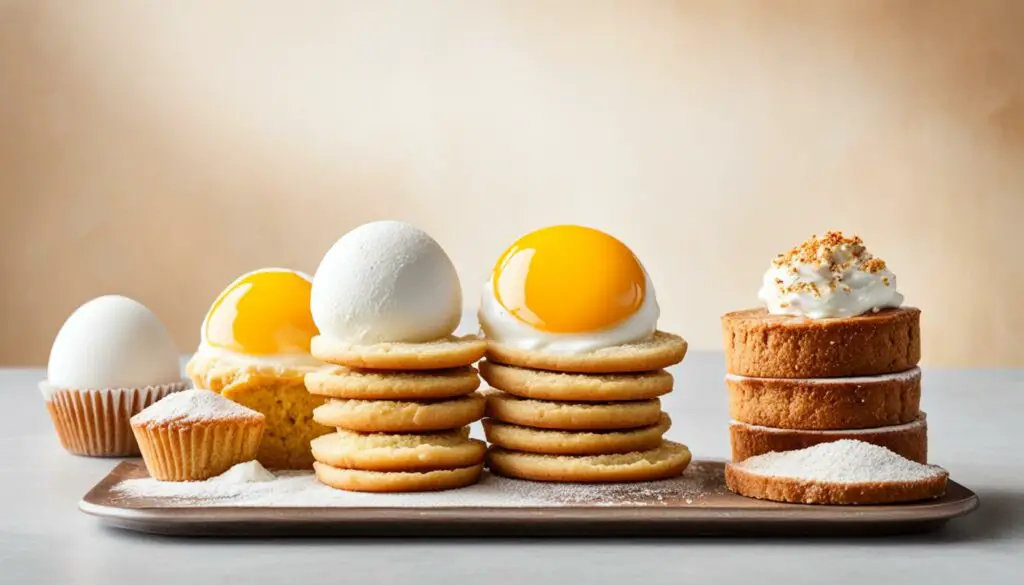
When it comes to baking, eggs play a crucial role as a leavening agent, helping your recipes rise and achieve a light and fluffy texture. But what if you don’t have eggs on hand or prefer to avoid them? Don’t worry, there are viable alternatives that can give you the same results. Let’s explore some egg substitutions as leavening agents.
If you’re looking for a convenient option, commercial egg replacement products are readily available. These products are specifically designed to mimic the leavening properties of eggs and can be used as a one-to-one replacement in your recipes.
Another option is to create your own leavening agent using a mixture of vegetable oil, water, and baking powder. This simple combination can work wonders in your recipes. Just mix 1 tablespoon of vegetable oil, 2 tablespoons of water, and 2 teaspoons of baking powder to replace one egg. This mixture will help your baked goods rise and achieve the desired lightness.
Here’s an example of the measurements:
| Ingredient | Measurement |
|---|---|
| Vegetable Oil | 1 tablespoon |
| Water | 2 tablespoons |
| Baking Powder | 2 teaspoons |
With these egg substitutions, you can confidently create light and fluffy baked goods without using traditional eggs. Whether you opt for commercial egg replacement products or choose to make your own leavening agent, the results will be deliciously satisfying.
Additional Egg Substitution Tips
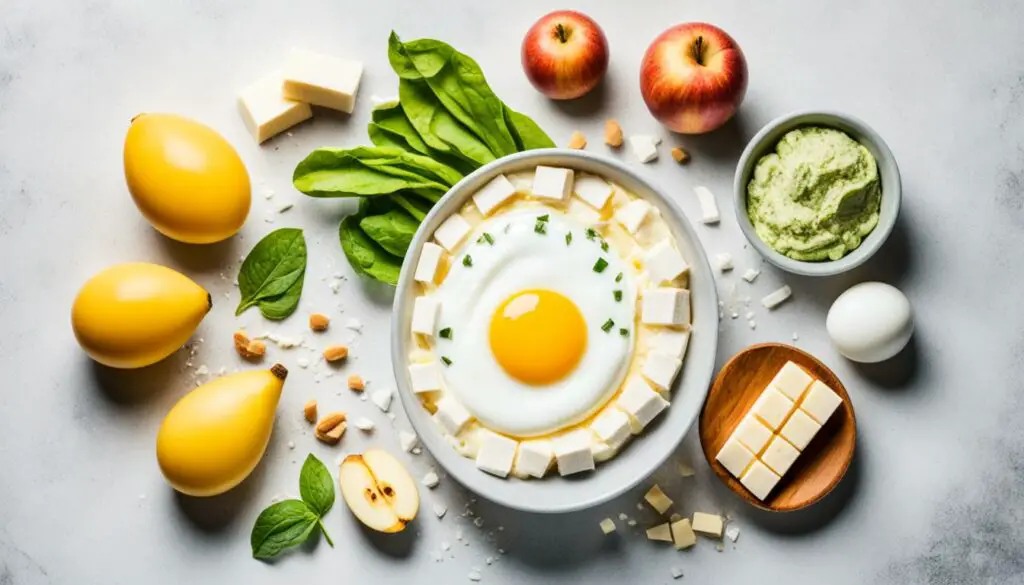
When it comes to substituting eggs in recipes, there are a few additional tips to keep in mind. Whether you’re looking to replace multiple eggs, replicate the airy texture of baked goods, or use alternative ingredients like tofu or fruit purées, these tips will help you achieve excellent results.
Recipes with Three or More Eggs
If a recipe calls for three or more eggs, it’s important to choose a suitable replacer that can perform the same function. Whether you need a binder or a leavening agent, there are various alternatives available. Consider using mashed banana, applesauce, gelatin blend, ground flaxseed mixed with warm water, or commercial egg replacement products to achieve the desired texture and structure in your recipe.
Replicating Airy Baked Goods
To replicate the light and airy texture of baked goods that typically require a significant number of eggs, it’s worth exploring recipes with similar taste profiles but fewer eggs. This way, you can still enjoy the flavors you love while reducing the egg content. Experiment with different recipes or look for egg-free variations that create a similar texture and taste.
Adding Tofu to a Recipe
Using tofu as an egg replacer can be a great option, especially in savory dishes. To ensure a smooth and consistent texture without any tofu chunks, it’s essential to purée the tofu first. Simply blend the tofu until it reaches a creamy consistency, which can then be used as a replacement for eggs in dishes like scrambles or quiches.
Powdered Egg Replacers
While there are various egg replacers available in powdered form, it’s important to note that they may not be suitable for all applications. Powdered egg replacers are best suited for baking rather than creating egg-based recipes like scrambles or omelets. When using powdered egg replacers, carefully follow the instructions provided to ensure optimal results.
Fruit Purées for Lighter Texture
Fruit purées, such as applesauce or mashed banana, can be used as egg substitutes to achieve a lighter texture in baked goods. However, it’s important to note that fruit purées add moisture to the recipe. To compensate for this additional moisture, consider adding extra baking powder to help maintain the desired structure and texture in your baked treats.
By following these additional egg substitution tips, you can confidently replace eggs in your favorite recipes while still achieving delicious and satisfying results.
The Science of Substituting Egg Yolks
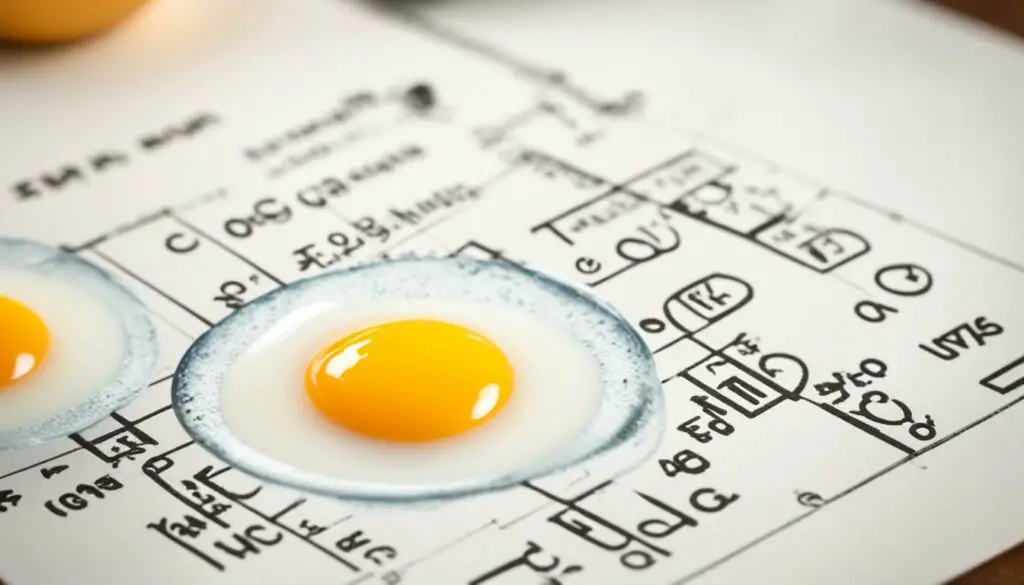
Substituting egg yolks for whole eggs involves understanding the properties and culinary functions of egg yolks. Egg yolks are rich in fats, emulsifiers, and cholesterol, which contribute to the richness, color, and texture of dishes.
The culinary functions of egg yolks include:
- Binding: Egg yolks act as natural binders, holding ingredients together in recipes.
- Thickening: The proteins in egg yolks thicken sauces, custards, and other liquid-based dishes.
- Providing Moisture: Egg yolks contribute moisture to baked goods, creating a tender and moist texture.
When choosing the right egg yolk substitute, it’s important to identify the main function of the yolks in the recipe and select an appropriate alternative. Here are a few options:
| Egg Yolk Substitute | Main Function |
|---|---|
| Mashed Banana | Binding and Moisture |
| Applesauce | Binding and Moisture |
| Gelatin Blend | Binding and Thickening |
| Ground Flaxseed mixed with warm water | Binding and Moisture |
| Commercial Egg Replacement Products | Binding and Moisture |
When using yolk substitutes, adjustments may need to be made in the recipe to ensure the proper balance between wet and dry ingredients. It may also be necessary to experiment and adjust the amount of substitute used to achieve the desired texture and flavor.
With a basic understanding of the science behind substituting egg yolks, you can confidently explore alternative options and create delicious dishes without traditional eggs. The key is to select substitutes that replicate the binding, thickening, and moisture properties of egg yolks, and to make any necessary adjustments to your recipes to maintain the proper balance of ingredients.
Conclusion
In conclusion, substituting egg yolks with whole eggs or other alternatives is a viable option in both cooking and baking. By understanding the roles of eggs in recipes and the properties of egg yolks, you can make informed decisions when substituting eggs. The tips and techniques provided in this article can help you successfully replace egg yolks in your favorite recipes without compromising on taste and texture.
Experimenting with different substitutions allows you to embrace the versatility of cooking and baking without traditional eggs. Whether you choose to use basic substitutes like peanut butter or ground flax, or explore options like tofu or commercial egg replacement products, there are various ways to achieve delicious results. Remember to consider the specific function of the eggs in the recipe and adjust other ingredients if necessary for the perfect balance.
With these cooking and baking tips in mind, you can confidently embark on your culinary adventures and create a wide range of dishes without relying solely on egg yolks. Enjoy the freedom to experiment with recipe substitutions and discover new flavors and textures in your favorite meals and treats!
FAQ
Can I use a whole egg when a recipe calls for egg yolks?
Yes, you can use a whole egg as a substitute for egg yolks in recipes. However, it’s important to understand the roles of egg yolks and whole eggs in recipes before making the substitution.
What are the roles of eggs in recipes?
Eggs play crucial roles in recipes, including providing structure, moisture, leavening, and flavor. Egg yolks contribute to the richness, fat content, and moisture of dishes, while egg whites help create volume and firmness.
What are some basic substitutions for egg yolks?
You can use alternatives such as peanut butter, ground flax, chia seeds, soy protein, banana, applesauce, and agar agar as substitutes for egg yolks in recipes.
How can I substitute eggs in cooking?
Tofu is a notable substitute for eggs in recipes that call for a lot of eggs, such as quiches or custards. You can puree tofu and use it as a replacement for one egg in a recipe.
How can I substitute eggs in baking as a binder?
Alternatives such as mashed banana, applesauce, gelatin blend, ground flaxseed mixed with warm water, or commercial egg replacement products can be used as substitutes for egg yolks as binders in baking.
How can I substitute eggs in baking as a leavening agent?
You can try using commercial egg replacement products or a mixture of vegetable oil, water, and baking powder as substitutes for eggs as leavening agents in baking.
Do you have any additional tips for substituting eggs in recipes?
Yes, here are some additional tips: when a recipe calls for three or more eggs, choose a replacer that will perform the same function, either binding or leavening. To replicate airy baked goods that require a lot of eggs, find a recipe with a similar taste but fewer eggs. When adding tofu as an egg replacer, make sure to purée it first to avoid chunks. Powdered egg replacers are not suitable for creating egg-based dishes like scrambles or omelets. If using fruit purées as an egg substitute, add extra baking powder to achieve a lighter texture.
What should I consider when substituting egg yolks?
When substituting egg yolks, it’s important to understand their properties and culinary functions. Egg yolks are rich in fats, emulsifiers, and cholesterol, which contribute to the richness, color, and texture of dishes. Consider the main function of the yolks in the recipe and choose an appropriate alternative. Also, adjust the recipe to ensure the proper balance between wet and dry ingredients when using yolk substitutes.



